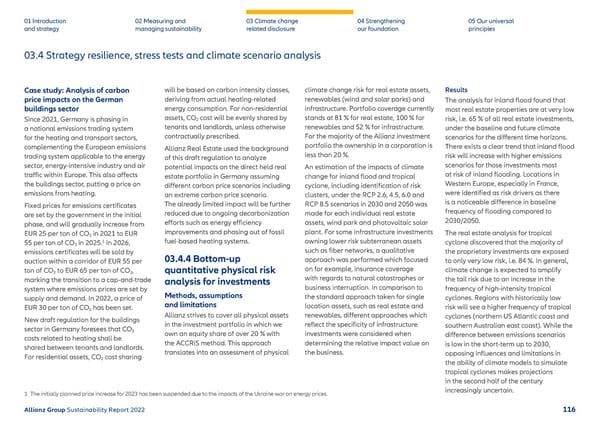01 Introduction and strategy 02 Measuring and managing sustainability 03 Climate change related disclosure 04 Strengthening our foundation 05 Our universal principles Case study: Analysis of carbon price impacts on the German buildings sector Since 2021, Germany is phasing in a national emissions trading system for the heating and transport sectors, complementing the European emissions trading system applicable to the energy sector, energy-intensive industry and air traffic within Europe. This also affects the buildings sector, putting a price on emissions from heating. Fixed prices for emissions certificates are set by the government in the initial phase, and will gradually increase from EUR 25 per ton of CO 2 in 2021 to EUR 55 per ton of CO 2 in 2025. 1 In 2026, emissions certificates will be sold by auction within a corridor of EUR 55 per ton of CO 2 to EUR 65 per ton of CO 2 , marking the transition to a cap-and-trade system where emissions prices are set by supply and demand. In 2022, a price of EUR 30 per ton of CO 2 has been set. New draft regulation for the buildings sector in Germany foresees that CO 2 costs related to heating shall be shared between tenants and landlords. For residential assets, CO 2 cost sharing will be based on carbon intensity classes, deriving from actual heating-related energy consumption. For non-residential assets, CO 2 cost will be evenly shared by tenants and landlords, unless otherwise contractually prescribed. Allianz Real Estate used the background of this draft regulation to analyze potential impacts on the direct held real estate portfolio in Germany assuming different carbon price scenarios including an extreme carbon price scenario. The already limited impact will be further reduced due to ongoing decarbonization efforts such as energy efficiency improvements and phasing out of fossil fuel-based heating systems. 03.4.4 Bottom-up quantitative physical risk analysis for investments Methods, assumptions and limitations Allianz strives to cover all physical assets in the investment portfolio in which we own an equity share of over 20 % with the ACCRiS method. This approach translates into an assessment of physical climate change risk for real estate assets, renewables (wind and solar parks) and infrastructure. Portfolio coverage currently stands at 81 % for real estate, 100 % for renewables and 52 % for infrastructure. For the majority of the Allianz investment portfolio the ownership in a corporation is less than 20 %. An estimation of the impacts of climate change for inland flood and tropical cyclone, including identification of risk clusters, under the RCP 2.6, 4.5, 6.0 and RCP 8.5 scenarios in 2030 and 2050 was made for each individual real estate assets, wind park and photovoltaic solar plant. For some infrastructure investments owning lower risk subterranean assets such as fiber networks, a qualitative approach was performed which focused on for example, insurance coverage with regards to natural catastrophes or business interruption. In comparison to the standard approach taken for single location assets, such as real estate and renewables, different approaches which reflect the specificity of infrastructure investments were considered when determining the relative impact value on the business. Results The analysis for inland flood found that most real estate properties are at very low risk, i.e. 65 % of all real estate investments, under the baseline and future climate scenarios for the different time horizons. There exists a clear trend that inland flood risk will increase with higher emissions scenarios for those investments most at risk of inland flooding. Locations in Western Europe, especially in France, were identified as risk drivers as there is a noticeable difference in baseline frequency of flooding compared to 2030/2050. The real estate analysis for tropical cyclone discovered that the majority of the proprietary investments are exposed to only very low risk, i.e. 84 %. In general, climate change is expected to amplify the tail risk due to an increase in the frequency of high-intensity tropical cyclones. Regions with historically low risk will see a higher frequency of tropical cyclones (northern US Atlantic coast and southern Australian east coast). While the difference between emissions scenarios is low in the short-term up to 2030, opposing influences and limitations in the ability of climate models to simulate tropical cyclones makes projections in the second half of the century increasingly uncertain. 1 The initially planned price increase for 2023 has been suspended due to the impacts of the Ukraine war on energy prices. 03.4 Strategy resilience, stress tests and climate scenario analysis Allianz Group Sustainability Report 2022 116
 Sustainability Report 2022 | Allianz Page 116 Page 118
Sustainability Report 2022 | Allianz Page 116 Page 118